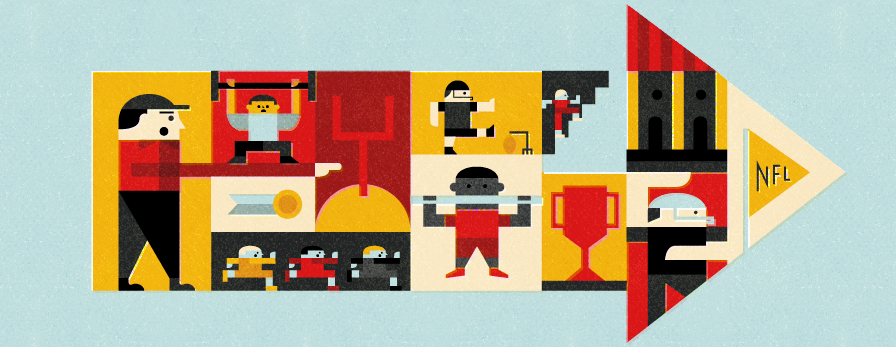Key Findings
- Any given recruit is more likely to make an NFL roster if they are on a better college team as measured by the AP rankings.
- 5-star recruits—the most elite athletes making up only 2.6% of the recruit sample—are far from a lock to make the professional ranks. Those 5-star recruits have less than a 50% chance at seeing the NFL.
- For coaches with over 100 recruits in the sample, the high end of the distribution is roughly 20-30% of their recruits making an NFL roster.
- A 5-star recruit is 14 percentage points more likely than the omitted category (2 and 1-star recruits) to make an NFL roster. A 4-star is 5.4 percentage points more likely to see the NFL, and a 3-star is half of that.
- The difference between a 5-star and a 4-star’s probability of making the NFL is about 8.5 percentage points.
By Kevin Rask
Colorado College
So many high school football players who are ranked by the recruiting services dream of one day making an NFL roster. So few actually do—and so many questions surround young players’ potential for development during college. Is it only the 5-star recruits who eventually populate the NFLs rosters or do 3-star recruits have just as good a chance to make a team? Is there a big conference bias or do the combine numbers and individual characteristics trump the pedigree?
In this study, we sought to answer the question of what affect does a college football head coach have on a recruit’s development. 1 Because we are able to observe multiple players going through a system with a single coach, we are able to estimate coach fixed-effects of the probability of a player making a professional roster. 2
The data used for the estimation of the logit model consists of 24,090 college football recruits rated by Rivals.com as a 1-star to a 5-star recruit between the years of 2003 and 2011. Football Recruiting PerformanceWe researched 10 years (2001-2010) and 12,000+ NCAA D-I football players’ recruiting class ranking to explore relationships between 3+ star recruits and all other recruits for two things: success on the field (wins) and success in developing talent (NFL draft picks). Read moreThe cutoff of 2011 was used because that is the most recent class that has started to show up on NFL rosters in significant numbers. To these recruits we matched the characteristics of the school they attended. Finally, the names of players on NFL rosters since 2003 were merged to create the dependent variable. Table 1 contains the overall probability of making an NFL roster depending upon your recruiting rating for recruits from 2003-2011. As you can see even 5-star recruits, the most elite athletes who make up only 2.6% of the recruit sample, are far from a lock to make the professional ranks. Those 5-star recruits have less than a 50% chance at seeing the NFL.
Table 1: The Distribution of Recruits from ’03-’11 and the Proportion that make an NFL Roster
| 1-Star | 2-Star | 3-Star | 4-Star | 5-Star | Total | |
| Number | 6 | 1,286 | 15,579 | 6,595 | 624 | 24,090 |
| % of Total Recruits | .02% | 5.3% | 64.7% | 27.4% | 2.6% | |
| % on NFL Roster | 0% | 7.5% | 11.6% | 19.8% | 47.0% | 14.5% |
There are 197 FBS head coaches in the ’03-’11 sample. The range in proportion of their recruits that make an NFL roster is quite large. For coaches with over 100 recruits in the sample, the high end of the distribution is roughly 20-30% of their recruits making an NFL roster. Coaches like Larry Coker and Mark Richt are at the high end of this group, and Lloyd Carr, Bill Callahan, and Urban Meyer at the lower end of the top of the distribution.
This descriptive information is important, however, it does not control for the type of recruits that these coaches get. If they were getting mostly 5-star athletes, given the overall probabilities from Table 1, they would likely be underperforming relative to their peers in terms of developing professionals.
To estimate the independent effect of the coach on the likelihood of a recruit making the pros you have to control for the type of recruits the coach is getting along with other characteristics of the recruit, the team, and the program.
Table 2 contains the results of the econometric model predicting whether a recruit ever makes an NFL roster. The partial probabilities from the logit model are reported and all but the impact of program expenditures are different from zero at the 99% level of confidence.
A 5-star recruit is 14 percentage points more likely than the omitted category (2 and 1-star recruits) to make an NFL roster. A 4-star is 5.4 percentage points more likely to see the NFL, and a 3-star is half of that. The sign and relative magnitude of these estimates make intuitive sense, however, the magnitude is relatively small. These magnitudes highlight the difficulty in predicting who will make it to the NFL.
Interestingly, all else equal, taller players are less likely to play in the pros, while heavier players are more likely. Finally, any given recruit is more likely to make an NFL roster if they are on a better college team as measured by the AP rankings.
Table 2: The Partial Probability Estimates from the Logit Panel Model
| Variable | Partial Probability Estimate | P-Value |
| Rival 5-Star | .139 | .000 |
| Rival 4-Star | .054 | .000 |
| Rival 3-Star | .027 | .006 |
| Height | -.018 | .000 |
| Weight | .001 | .000 |
| Team Final AP Ranking | -.0001 | .000 |
| Ln (Program Expenditures) | -.023 | .301 |
| Conference Fixed Effects | Yes | |
| Observations: | 24,090 |
The model above was used in the estimation of the individual coach fixed-effects on the probability of a recruit making an NFL roster. Of the 197 coaches in the database, effects could only be estimated for 129 of them because the rest have not had any eventual NFL players. Some of the estimates are also imprecisely estimated because of the low number of recruits a particular coach has. For example, while head coach at UTEP Gary Nord had a 50% rate of turning his Rival-rated recruits into NFL players. However, that rate only applied to 4 recruits.
Table 3 highlights the Top 30 coaches, those at the high end of the fixed-effects model estimates who also have had 40 or more recruits during the sample period.
Table 3: Final Model Estimates of Individual Effect of Head Coaches on a Recruit Making the NFL
| Coach | % on NFL Roster | Total Rival Recruits | Model Relative Rating |
| Chris Petersen | 25% | 76 | .163 |
| Tom Craft | 24% | 51 | .163 |
| Joe Novak | 21% | 34 | .150 |
| Chuck Long | 21% | 47 | .149 |
| June Jones | 19% | 43 | .117 |
| Tom Amstutz | 16% | 44 | .093 |
| Randy Shannon | 25% | 252 | .084 |
| Mark Richt | 28% | 598 | .072 |
| Bill Callahan | 23% | 209 | .067 |
| Ed Orgeron | 20% | 127 | .064 |
| Larry Coker | 28% | 301 | .063 |
| Ron Zook | 23% | 426 | .056 |
| Dirk Koetter | 18% | 209 | .056 |
| Karl Dorrell | 19% | 257 | .053 |
| Ed Kezirian | 19% | 32 | .053 |
| Bret Bielema | 23% | 248 | .052 |
| Bobby Johnson | 9% | 587 | .047 |
| Joe Tiller | 17% | 244 | .043 |
| Tyrone Willingham | 17% | 154 | .042 |
| Chan Gailey | 17% | 147 | .040 |
| Al Groh | 20% | 355 | .039 |
| Mike Bellotti | 19% | 315 | .037 |
| Jim Grobe | 12% | 186 | .034 |
| Tommy Tuberville | 14% | 264 | .034 |
| Randy Edsall | 12% | 68 | .030 |
| Randy Walker | 15% | 102 | .029 |
| Pat Hill | 10% | 146 | .029 |
| Mack Brown | 21% | 630 | .028 |
| Mike Hankwitz | 13% | 76 | .025 |
| Jon Tenuta | 15% | 40 | .025 |
Topping the list is Chris Peterson, formerly of Boise State. Controlling for the quality of his recruits, on average his players were 16.3 percentage points more likely to land on an NFL roster than the players for the average FBS head coach. We can also look at someone like Mack Brown—who has the most Rivals starred recruits in the database (630) and landed a significant 21% of them in the NFL—however, given the quality of his recruits, he was only about 3 percentage points better than the average FBS coach at turning them into professionals.
To put these numbers in perspective we can look at the estimates from Table 2. The difference between a 5-star and a 4-star’s probability of making the NFL is about 8.5 percentage points. That is roughly the same difference between Randy Shannon and the average FBS head coach.
So, while we still cannot accurately predict which elite high school athletes will play at the highest level, we can see (with some caveats), which college coaches give recruits the best chance at a professional career. Controlling for our variables, these are the coaches that truly make the most of the young athletes ability, and—while not always from the largest or most well funded programs—they are clearly developing skills in ways that provide more tangible benefit than the instruction at other programs.
Win AD helps you discover the next great coaching talent—from within your own league or from the ranks of those ready to ascend to higher divisions. With a database of more than 42,000 coaches in D-I and D-II, Win AD provides ADs and CFOs detailed information on performance—as well as salaries—including .pdf contracts and outside income reports. Win AD gives you everything you need to find talent.
References:
- We utilized a panel of data on all of Rivals two, three, four, and five-star football recruits from 2003-2011, all FBS head coaches from 2003-2013, NFL rosters from 2003-2013, and school football expenditures, team success measures, and conference affiliations from 2003-2013. The panel data is used to estimate what is essentially an NFL roster production function with inputs consisting of players (their recruiting rating, height, and weight), school expenditures, team success (the team’s final AP ranking of the season), and conference affiliation. The panel is organized around the coach where every coach has a stream of high school recruits, a level of expenditures, and a level of team success and national exposure because of the conference in which they compete. ↩
- There are some limitations to this study because of the data. We are unable to directly measure the fixed effects because the dependent variable (on an NFL roster) is a dichotomous variable. However, we were able to estimate two kinds of panel data logistic (logit) models, a pooled model and a panel model. Utilizing the predicted probabilities of each player making an NFL roster from both of these models we then group them by coach and calculate an average difference for each coach between the base estimates and the panel estimates. These difference serve as our estimate of each coaches higher or lower ‘average’ influence on their players’ likelihood of making an NFL roster.
A second caveat is that we were unable to estimate fixed effects for all coaches. If a coach doesn’t have any players that ever make a roster (or, in the unlikely event they have every player make an NFL roster) the model cannot estimate an effect for them because there is no variability in outcomes.
A third caveat is that there will be some random measurement error in some of the covariates. We also do not have year-to-year detail on college attendance, so players who transfer will be attributed the starting college characteristics instead of some weighted combination of total experience. ↩




